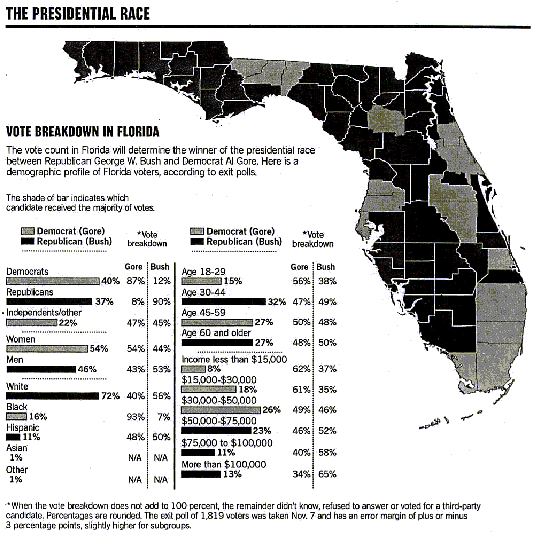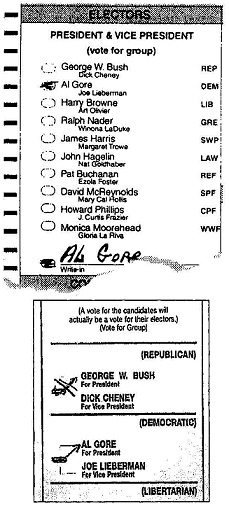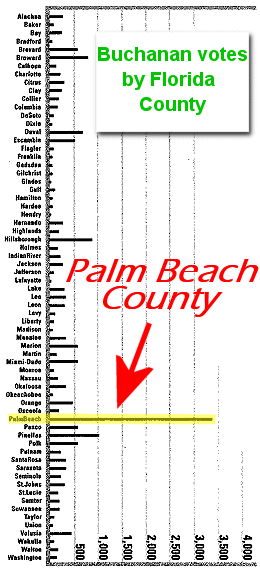Dispelling the Myth of Election 2000:
|

|
Questioning the Myth
George Bush beat Al Gore by only 543 votes in Florida. Gore needed Florida’s electoral votes in order to win the presidency. He did not get them. Gore’s diehard Democratic Party supporters have declared Green Party presidential candidate Ralph Nader the reason their candidate lost the 2000 presidential election, even though numerous other factors in the climactic Florida vote-counting drama affected the outcome. Instead of focusing solely on the votes Ralph Nader took from Al Gore, a balanced analysis would also take into account the following: (1) voters who were disenfranchised; (2) voting systems and procedures that failed; (3) the party-line United States Supreme Court vote declaring George W. Bush the winner; and (4) Democrats who voted for Bush or not at all.
Disenfranchised By Design?
The Florida Secretary of State’s Office hired a private firm known as Database Technologies, Inc. (now ChoicePoint Corporation) to identify convicted felons and remove them from Florida’s voting rolls. Prior to the election, 94,000 voters were removed (Kelly, 2002). This is legal if someone has been convicted of a felony, but as it turns out, 97 percent were innocent and should not have been removed. "The list was full of mistakes mainly because of the criteria [the database company] used. It compared its list of felons with the Florida voting rolls by looking for a rough match between the names and dates of birth. Thus a Christine Smith could have been disqualified if there had been a Christopher Smith of the same age with a felony record somewhere in the US. [the database company] also used race as a matching criterion, skewing the impact of the errors even more against black voters" (Borger & Palast, 2001). As The Nation magazine reported, "immediately after the November 7, 2000 election, minority voters who had never committed crimes complained of having had their names removed from voting rolls in a purge of ‘ex-felons,’ of being denied translation services required by law, … and of harassment by poll workers and law-enforcement officials." The list of voters denied the right to vote was overwhelmingly Democratic and half were minorities (Kelly, 2002). Al Gore neither protested the disenfranchisement nor supported these voters’ lawsuit to regain their vote.
Voting Systems and Procedures
Voting systems throughout Florida (as well as the country) varied in makeup, and some had seriously flawed ballots. Since the 2000 presidential election, 11,000 election-related complaints have been registered in Florida, and some reforms have been implemented.
Ballots discarded
|
Paper and Pencil Ballot
Some Florida counties used a paper and pencil ballot. Some of these counties sent their ballots to the county seat (election headquarters) for tabulation, while others tallied votes at the polling place. When votes were counted at a county election headquarters, voters were not given a chance to revote if they had made a mistake, such as double voting or making an illegible mark on a ballot, and, in this scenario, African-Americans were four times as likely as whites to have their ballots thrown out (Keating & Mintz, 2001). In the tally-on-site counties, voters were told immediately if they had made a mistake and were given a second chance to vote (ibid). In these second-chance counties, African-Americans were just under two times as likely as whites to have ballots tossed out. With nine out of ten African-American voters voting Democratic and two-thirds of white voters voting Republican, the use of voting systems that lacked a second-chance option represented a net advantage for Bush of thousands of votes.
One common type of disqualified ballot, called a double bubble, showed a double vote for president in that a voter marked the oval next to the candidate’s name and then also marked the oval next to "write in" and wrote in the same candidate’s name. A Washington Post review (2001) found that Gore would have had a net gain of 662 votes, enough to win, if there had been a hand recount of "over-votes," mostly from double bubbles.
Butterfly Ballot |
The Infamous Butterfly Ballot
The infamous butterfly ballot has punch holes running down the center and the list of candidates on pages to the left and right of these holes. Butterfly ballots are the most prone to voter confusion as it is not clear which hole goes with which candidate. Palm Beach County, the one county in Florida that used this system, is a predominantly Democratic-leaning county yet extreme conservative candidate Pat Buchanan had a phenomenal showing there. On the left side of the Palm Beach County ballot George Bush was listed first and Al Gore second. However, the second punch hole in the center of the ballot was for Pat Buchanan, the first candidate listed on the right.
Pat Buchanan himself has admitted that most of his votes in Palm Beach County were meant for Al Gore, saying he "did not campaign and bought no advertising there" (Nichols, 2001, p. 86). He added, "I would say 95 to 98 percent of [the votes] were for Gore" (id. at p. 89). The day after the election, many people were upset, saying the butterfly ballot was confusing. When the election results were "too close to call," Buchanan worried he would be charged with costing Gore the election. He said he got more media coverage after the election than he did during the campaign (id. at p. 84). The graph to the left showing an abnormally high Buchanan vote in Palm Beach County suggests the butterfly ballot cost Al Gore thousands of votes, more than enough to have won the presidency.
The "Supreme" Test
The United States Supreme Court voted five to four along party lines to uphold the vote certified by the Florida Secretary of State, Kathleen Harris, declaring George Bush the winner in Florida. Between undercounts and overcounts, that vote count was riddled with inequities. Harris’s role has been sharply criticized because she worked for the Bush campaign, and thus had a direct conflict of interest.
Because varying voting standards were used within different counties, the Florida Supreme Court said it was each county’s responsibility to ensure ballots were treated uniformly. Some counties began a manual recount of the vote. The United States Supreme Court, however, stopped the manual recount altogether by requiring canvassing boards to meet an impossible Electoral College deadline.
In the book The Unfinished Election of 2000 (2001), Pamela S. Karlan wrote, "There is something disquieting about the fact that although the Court focused largely on the claims of excluded voters, the remedy it ordered simply excluded more voters yet" (id. at p. 192). "[N]either Al Gore’s counsel nor the Court ever addressed the threshold question of standing and whose rights were being remedied" (ibid.). As Justice John Paul Stevens wrote in his dissenting opinion, "Although we may never know with complete certainty the identity of the winner of this years Presidential election, the identity of the loser is perfectly clear. it is the nation’s confidence in the judge as an impartial guardian of the rule of law." (Justices Ginsburg and Breyer joined Justice Stevens in his dissenting opinion.)
Florida Voters
Even if none of the factors mentioned above had happened, the votes of Florida voters themselves show that Ralph Nader was not responsible for George W. Bush's presidency.
"Democrats for Bush, Democrats for nobody"
"Twelve percent of Florida Democrats (over 200,000) voted for Republican George Bush"
-San Francisco Chronicle, Nov. 9, 2000
Even if none of the factors mentioned above had happened, the votes of Florida voters themselves show that Ralph Nader was not responsible for George W. Bush’s presidency. If one percent of these Democrats had stuck with their own candidate, Al Gore would easily have won Florida and become president. In addition, half of all registered Democrats did not even bother going to the polls and voting.
|
The Florida Vote |
|
|
Republican |
2,912,790 |
|
Democratic |
2,912,253 |
|
Green |
97,488 |
|
Natural Law |
2,281 |
|
Reform |
17,484 |
|
Libertarian |
16,415 |
|
Workers World |
1,804 |
|
Constitution |
1,371 |
|
Socialist |
622 |
|
Socialist Workers |
562 |
|
Write-in |
40 |
The Final Count
According to the official 2001 Statistics of the Presidential and Congressional Election of November 7, 2000, George W. Bush beat Al Gore in Florida by 543 votes. It is noteworthy that every third-party candidate received enough votes in Florida to have cost Al Gore the election.
Conclusion
Green Party Presidential Candidate Ralph Nader did not work for the Florida Secretary of State, the Palm Beach County Election Commission, the Al Gore campaign committee, or the United States Supreme Court. Yet, he has become a scapegoat among many Democrats for Al Gore’s loss of the 2000 election, and, beyond the election, the person to blame for the resulting policies of George Bush. These diehard Democrats are averse to looking at the failings of their candidate, and they are not blaming voters for failing to vote at all. Instead, they are upset that Ralph Nader did not acquiesce to dropping out of the race as many urged him to do. As a side note, if Al Gore had won his home state of Tennessee, he would have had the necessary Electoral College votes to have won the election and the Florida results would have been irrelevant.
The facts are compelling and undeniable that Ralph Nader is not the reason, and should not be blamed, for George Bush’s victory in the 2000 presidential election.
-Irene Dieter, May 2003



